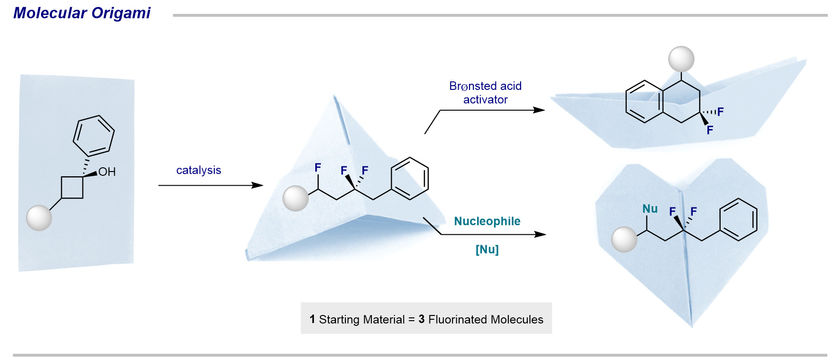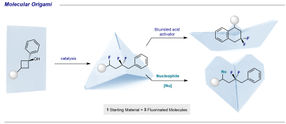Chemists develop reaction cascade to produce fluorinated molecules
"Molecular origami" creates new structures in a single operation
fluorine is found rarely in naturally occurring organic molecules. However, this chemical element is indispensable for the production of pharmaceuticals or agrochemicals. synthetic chemistry has an important role to play in the development of new fluorine-containing molecular fragments. Simple, modular synthesis strategies are extremely valuable. A team led by Prof. Ryan Gilmour at the Organic Chemistry Institute at the University of Münster have now developed a cascade reaction that enabled multiple Fluorination reactions to occur through the sequential generation of reactive intermediates. Using inexpensive organic catalysts and simple starting materials, the group has shown that the substrate can be manipulated through a type of “molecular origami” to generate a new class of di- and trifluorinated molecules in a single operation. The study is published in the journal "Nature Communications".

The series of folding steps represents successive reactions. Starting from the simple cyclobutanol starting material ("piece of paper"), an isolable intermediate compound can be produced ("origami hat"). By adding a Brønsted acid activator, an intramolecular cyclisation is triggered, which leads to high value-added tetralin derivatives ("origami boat"). Alternatively, so-called nucleophiles can be introduced by activating the benzylic carbon-fluorine bond ("origami heart").
Copyright: WWU Münster - AG Gilmour

Crystal structure (grey: Carbon, C; green: Fluorine, F; red: Oxygen, O) of the novel fluorinated Nafenopin derivative, which was synthesized using a precursor prepared with the described methodology. Right: Structure of Nafenopin. Rechts: Struktur von Nafenopin.
Copyright: WWU Münster - AG Gilmour


The step-wise construction of complex fluorinated molecules may require multiple purification steps. This has implications in terms of costs, time-management and the generation of waste. Dr Joel Häfliger and Dr Louise Ruyet from Ryan Gilmour's research group discovered that by fine-tuning the reaction conditions, multiple sequential reactions are possible in a one pot fashion. In this way, they generated three new classes of complex fluorinated products from simple cyclobutanol derivatives. "The strategy has parallels with the art of origami, where you fold complex figures from a simple piece of paper," Louise Ruyet illustrates. "This principle can be transferred to our chemical method."
The multiple folding steps represents successive reactions. "Starting with our piece of paper – the cyclobutanol-derivative – an intermediate compound is produced. This compound can be processed into different products depending on the reaction conditions," says Joel Häfliger, the lead author of the paper. The key to the success of the approach was the use of an acidic medium to activate the substrate and produce an intermediate that can be intercepted by a catalytic cycle. The team synthesised a fluorinated analogue of the agent Nafenopin, which is used for hypolipidaemia – a strikingly low lipid level in the blood – as an application example.
Original publication
See the theme worlds for related content
Topic world Synthesis
Chemical synthesis is at the heart of modern chemistry and enables the targeted production of molecules with specific properties. By combining starting materials in defined reaction conditions, chemists can create a wide range of compounds, from simple molecules to complex active ingredients.

Topic world Synthesis
Chemical synthesis is at the heart of modern chemistry and enables the targeted production of molecules with specific properties. By combining starting materials in defined reaction conditions, chemists can create a wide range of compounds, from simple molecules to complex active ingredients.






























































